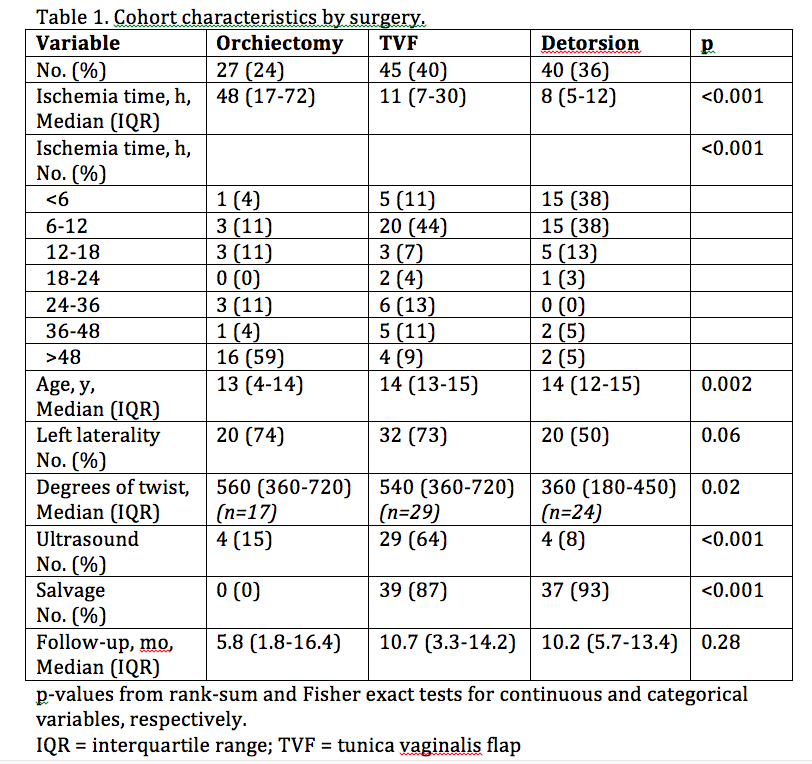Tunica Vaginalis Flap for Salvaging Testicular Torsion: A Matched Cohort Analysis.
David I. Chu, MD, Jason P. Van Batavia, MD, Kavita Gupta, MD, Angela Kalmus, BA, Trudy Kawal, MD, Diana K. Bowen, MD, Dana A. Weiss, MD, Stephen A. Zderic, MD, Douglas A. Canning, MD.
Children's Hospital of Philadelphia, Philadelphia, PA, USA.
Introduction:
Testicular torsion is a highly time-dependent pathology in which estimated ischemia time from pain onset impacts ability to salvage the testicle. One technique for enhancing salvage rates at time of surgery is a tunica albuginea fasciotomy to relieve compartment pressure followed by a tunica vaginalis flap (TVF). Use of TVF may thus decrease orchiectomy rates. To date, however, the optimal window of ischemia time during which TVF may be most beneficial to avoid orchiectomy is unknown. We hypothesized that a TVF may be most beneficial for ischemia times >24 hours.
Methods:
We performed a retrospective matched cohort study of males presenting with testicular torsion at our single tertiary-care institution from June 2002 to March 2017. Males who had bilateral torsion, lacked data on ischemia time, had ischemia time >96 hours, or had no postoperative follow-up visit were excluded. Post-operative testicular salvage was determined by clinical judgment on follow-up examination or presence of blood flow if follow-up scrotal ultrasound was performed. Ischemia time, defined as patient-reported duration of pain from onset to surgery, and salvage rates were compared across orchiectomy, TVF, and detorsion alone groups. Cases of torsion treated with TVF were matched 1:1 with replacement with males treated with orchiectomy, with Mahalanobis distance and caliper matching on age at surgery and exact matching on ischemia time. Rates of post-operative salvage with TVF were assessed by ischemia time.
Results:
A total of 112 patients met eligibility criteria, of whom 45 underwent TVF. Median follow-up was 9.8 months. Median ischemia times were 48, 11, and 8 hours and post-operative salvage rates were 0, 87, and 93% in the orchiectomy, TVF, and detorsion groups, respectively (both p<0.001; Table 1). Among patients who had degrees of twist recorded, the detorsion alone group had lower degrees of twist (p=0.02). After matching on age and exact matching on ischemia time, 33 patients with TVF were matched to 33 patients who underwent orchiectomy (Table 2). Testicular salvage occurred in 4 of 6 patients with TVF having an ischemia time between 24-36 hours, and 2 of 4 patients with TVF having an ischemia time >48 hours, for a total salvage rate of 60% (6 of 10) for an ischemia time >24 hours. A limitation is that not every child underwent standardized scrotal ultrasound postoperatively to document radiologic testicular salvage or atrophy rates.
Conclusions:
Patients who present with testicular torsion can salvage their testicle through detorsion with fasciotomy and TVF. Those with ischemia times >24 hours who are at greatest risk for orchiectomy may potentially benefit the most from TVF. Prospective multi-institutional standardized follow-up with ultrasound is needed to further explore the potential benefits or harms of TVF.

Back to 2017 Program
